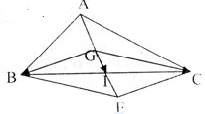Hãy nhập câu hỏi của bạn vào đây, nếu là tài khoản VIP, bạn sẽ được ưu tiên trả lời.

Câu 1:
Theo tính chất trọng tâm và đường trung tuyến, ta thấy \(\overrightarrow {AM}; \overrightarrow{GM}\) là 2 vecto cùng phương, cùng hướng và \(AM=3GM\)
\(\Rightarrow \overrightarrow{AM}=3\overrightarrow{GM}\)
\(=\frac{3}{2}(\overrightarrow{GM}+\overrightarrow{GM})\) \(=\frac{3}{2}(\overrightarrow{GB}+\overrightarrow{BM}+\overrightarrow{GC}+\overrightarrow{CM})\)
\(=\frac{3}{2}[(\overrightarrow{GB}+\overrightarrow{GC})+(\overrightarrow{BM}+\overrightarrow{CM})]\)
\(=\frac{3}{2}(\overrightarrow{GB}+\overrightarrow{GC})\) (vecto \(\overrightarrow{BM}; \overrightarrow{CM}\) là 2 vecto đối nhau nên tổng bằng vecto $0$)
Đáp án B
Câu 2:
\(\overrightarrow{u}=\overrightarrow{AB}+\overrightarrow{DC}+\overrightarrow{BD}+\overrightarrow{CA}\)
\(=(\overrightarrow{AB}+\overrightarrow{BD})+(\overrightarrow{DC}+\overrightarrow{CA})=\overrightarrow{AD}+\overrightarrow{DA}\)
\(=\overrightarrow{0}\) (tổng của 2 vecto đối nhau)
Đáp án C
Câu 3:
Bạn nhớ rằng \(\overrightarrow{a}; k\overrightarrow{a}(k\in\mathbb{R})\) luôn là 2 vecto cùng phương (tính chất vecto). Nhưng nó mới chỉ là cùng phương thôi. Muốn cùng phương +cùng hướng thì \(k>0\) ; muốn cùng phương + ngược hướng thì \(k< 0\). Nói chung là phụ thuộc vào tính chất của $k$
Câu C thì hiển nhiên sai.
Nên đáp án B đúng

\(\overrightarrow{AB}=\overrightarrow{AG}+\overrightarrow{GB}=\overrightarrow{b}-\overrightarrow{a}\)
\(\overrightarrow{GC}=0-\overrightarrow{GA}-\overrightarrow{GB}=-\overrightarrow{a}-\overrightarrow{b}\)
\(\overrightarrow{BC}=\overrightarrow{BG}+\overrightarrow{GC}=-\overrightarrow{b}-\overrightarrow{a}-\overrightarrow{b}=-\overrightarrow{a}-2\overrightarrow{b}\)
\(\overrightarrow{CA}=\overrightarrow{CG}+\overrightarrow{GA}=\overrightarrow{a}+\overrightarrow{b}+\overrightarrow{a}=2\overrightarrow{a}+\overrightarrow{b}\)

Bài 2:
Gọi M là trung điểm của AB,N là trung điểm của CD
vecto GA+vecto GB+vecto GC+vecto GD=vecto 0
=>2 vetco GM+2 vecto GN=vecto 0
=>vecto GM+vecto GN=vecto 0
=>G là trung điểm của MN

Kéo dài AG lấy E sao cho AG=GE
\(2\overrightarrow{GB}+\overrightarrow{GC}=\overrightarrow{GB}+\overrightarrow{GC}+\overrightarrow{GB}=\overrightarrow{GE}+\overrightarrow{GB}=\overrightarrow{AG}+\overrightarrow{GB}=\overrightarrow{AB}\)
\(\overrightarrow{GI}=\overrightarrow{IA}\Rightarrow6\overrightarrow{GI}=3\overrightarrow{GA}\)
\(\overrightarrow{AB}+\overrightarrow{AC}+3\overrightarrow{GA}=\overrightarrow{GB}+\overrightarrow{GC}+\overrightarrow{GA}=\overrightarrow{GE}+\overrightarrow{GA}=\overrightarrow{AG}+\overrightarrow{GA}=\overrightarrow{0}\)

Bài 1 và Bài 2 tương tự nhau nên mk sẽ chỉ CM bài 1 thôi nha
Có \(\overrightarrow{AB}=\overrightarrow{DC}\Rightarrow\overrightarrow{AB}+\overrightarrow{CD}=0\)
\(\Rightarrow\overrightarrow{AD}+\overrightarrow{DB}+\overrightarrow{CB}+\overrightarrow{BD}=0\)
\(\Leftrightarrow\overrightarrow{AD}+\overrightarrow{CB}=0\Leftrightarrow\overrightarrow{AD}=\overrightarrow{BC}\)
Bài 3:
Xét \(\Delta AIP\) theo quy tắc trung điểm có:
\(\overrightarrow{IC}=\frac{\overrightarrow{IA}+\overrightarrow{IP}}{2}\)
Làm tương tự vs các tam giác còn lại
\(\Rightarrow\overrightarrow{IB}=\frac{\overrightarrow{IN}+\overrightarrow{IC}}{2}\)
\(\Rightarrow\overrightarrow{IA}=\frac{\overrightarrow{IB}+\overrightarrow{IM}}{2}\)
Cộng vế vs vế
\(\Rightarrow\overrightarrow{IA}+\overrightarrow{IB}+\overrightarrow{IC}=\frac{\overrightarrow{IA}+\overrightarrow{IP}+\overrightarrow{IN}+\overrightarrow{IC}+\overrightarrow{IB}+\overrightarrow{IM}}{2}\)
\(\Leftrightarrow2\overrightarrow{IA}+2\overrightarrow{IB}+2\overrightarrow{IC}=\overrightarrow{IA}+\overrightarrow{IB}+\overrightarrow{IC}+\overrightarrow{IM}+\overrightarrow{IN}+\overrightarrow{IP}\)
\(\Leftrightarrow\overrightarrow{IA}+\overrightarrow{IB}+\overrightarrow{IC}=\overrightarrow{IM}+\overrightarrow{IN}+\overrightarrow{IP}\left(đpcm\right)\)
